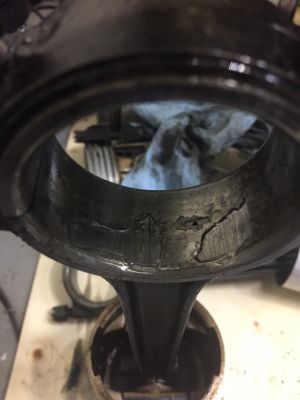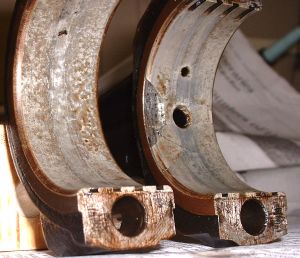- Home
- About Us
- Join/Renew
- Member Benefits
- Member Pages
- Log In
- Help
- Museum Store
Good Point George, a point well taken!
Al
This may sound like a naive question but I’m curious what folks have to say.
Would an 845 with 81,000 miles be considered a high mileage car? In other words, would one expect many things to be worn out by then?
I’m old enough to remember why cars had only 5-digit odometers. Getting 100,000 miles was a real achievement. But I would think that 81,000 miles on a Pierce Arrow might not have the same effect as 81,000 miles on a similar-vintage Buick. My ’32 Packard has 53,000 miles and it is nice and tight but I did need to replace the connecting rod bearings as they were literally falling apart.
Consider any car from the 1930’s with 40,000 miles as worn out. Maybe no all of them, but most. Remember these were cheap oddball cars till the 70’s and no one wanted to put in an extra dime.
Boy ain’t that the truth.
My opinion of engine rebuilding, having been through several Packards and Franklins, is that when someone “rebuilt” an engine in the 60’s, 70s’s even 1980’s, that meant new rings, a valve job, change the oil, adjust the points. If it ran, that’s all that was done. Just to be fair, a 1935 car was only 40 years old in 1975 and Babbitt was still in good shape.
Today’s definition of a total engine rebuild includes all new Babbitt bearings because Babbitt crystallizes with age. It may still look good, but you need to make sure the clearances are no more than 0.0015 on rods and mains. Otherwise any excessive pounding will crack and explode the Babbitt.
The photo is from my ’32 Packard when I bought it. It ran well but was a little clattery. After adjusting the valves, the clatter was still there so I dropped the pan and checked the rod bearings. Glad I did !
There is no substitute for doing things right. I have a 904 Packard, great driver!
Scott-even if the engine is perfectly quiet drop the pan and do an inspection. My ‘32 Club Brougham ran great, plenty of power and didn’t make a sound. When we dropped the pan and checked the first rod this what I saw. It wasn’t far from letting go and chewing up the crank journal. Hopefully yours will be fine but at least you will know. Also it’s a good idea to clean the crud that in the bottom and the pump pickup screen.

Right !
As your photograph and mine show, it’s not sufficient to just look at the rod bearing caps. You really need to check all around the bearing.
The damage you can inflict will cause you far greater headaches than being proactive and checking things out now.
I was told that if there is no sign of cracking or delamination, you could be OK to reassemble and drive the car but make sure to use Plastigauge to measure the bearing clearance. It should be 0.0015″ — one and one half thousandths. Two is OK.
It’s better than nothing to remove shims or file the cap to get down to the clearance you want, but you will leave the rod oval around the crank journal. (Unless it’s oval to begin with). As long as it’s only about 0.001″ out of round, it should be fine but if things are worn so that you have three thousandths or more, I’d just get new rod bearings while you’ve got everything apart.
When I did this to both Packards, I did not do the job fully but only rebabbitted the connecting rods. The mains looked good with reasonable clearances, plus on a 9 main bearing crankshaft, the mains don’t take as much pounding load as the rod bearings. But if you don’t remove the crankshaft, you will probably need to scrape in the newly Babitted rods. Not hard to do but time consuming to get a reasonable surface. Then the thick Babbitt will conform over time. You cannot do this with bearing inserts.
But make certain your crank journals are round and not too badly scored.
This is getting off topic but worth bringing up.

Back to the original question of how long it lasts and things to look for. One of the wear issues on 1930’s Pierce-Arrows is the ball bearing spring shackles system. Since I never drove my 845 in an “as-is” condition I don’t know if mine would have given any noticeable problems when driving, but they had definite wear issues. Others with actual experience driving them might be able to chime in here. Rechecking my original speedometer it was parked in 1948 with ~59000 miles.
The ball bearings of the upper hangers and shackles had pounded significant indentions into the pin races on the loaded side. The exception was the fwd end of the rear spring hangers that has larger diameter pins and balls. The aft bottom shackles of the front springs were complete toast – corrosion severe enough to literally turn many of the balls into red dust. I suspect this was more to do with sitting for decades with salty water in them. Before being retired this car would have been driven on salted Wisconsin roads in winter/spring and those shackles would be the most exposed to slush and water kicked up by the tires.
As I said, I don’t know to what extent the level of indention would have effected the noise or handling of the car.
Jim
Wouldn’t it be great to be able to have a tech session with the P-A
engineer who decided to introduce ball bearing spring shackles without
the ability to lubricate them easily? How could he justify that decision?
Throw in some original owner’s with their approach to the problem. I know
labor was cheap back then, but really! Did the attempt to make the easiest
riding car end up being an early attempt at planned obsolescence? Trade
your low mileage P-A in on a new one before you have to service those
shackles? I bet that meeting would be packed. I think some Studebaker
President owners would crash that meeting, too.
I would bet, from an engineering viewpoint, that the discussion of the spring shackle design was about the fact that there is negligible angular movement of the spring.
Thus, the ball bearing shackles did not rotate as most bearings do, in revolutions, but rather only slightly moved as the main spring leaf traveled through an arc of very few degrees.
I’d wager the thought was that a little grease upon installation, maybe a squirt of oil every now and then, was all they figured they needed.
Yes, I think the lack of actually needing to be lubricated was part of the reasoning. A ball bearing at very slow speed such as oscillating doesn’t really need any lubrication since it is mainly rolling not sliding, so the grease really wouldn’t be critical, its purpose partly to help the seals keep contaminants out. It was probably believed that the balls would actually last longer even if neglected.
The notion also seemed to be that it reduced the friction of the slight rotation of the spring as it deflected, but since the leaf spring system does not have enough damping a shock absorber is required anyway to introduce a much larger friction force to control deflection. Simple oscillating journal bearings with bushings can have a slip-stick problem if not well lubricated (which also creates wear). Perhaps one thought was that eliminating the friction at the shackle made the total damping of the shock more consistent. Many of the more expensive cars of course had the Bijur lubrication system to keep the shackles oiled.
The obvious problem of course was that non-rotating ball bearings aren’t great at large static loads where they constantly get hammered in the same location and pounded indentions into the pins. Larger size bearings would have helped (as I noted the larger diameter bearing on my rear spring hangers were fine) or the obvious solution looked at by many latter day restorers of changing to tapered roller or needle bearings that have much better static capacity.
My theories. Jim
